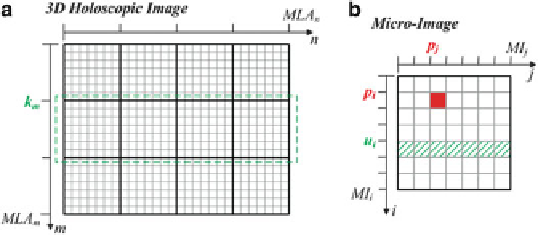Image Processing Reference
In-Depth Information
Fig. 5.4 Process to construct each representations format of the 3D holoscopic content
5.3.2 Viewpoint Image Based Representation
A viewpoint image based representation can be constructed by extracting one pixel
(with the same relative position) from all micro-images of a given 3D holoscopic
image. Hence, each resulting viewpoint image represents an orthographic projec-
tion of the complete 3D scene in a particular direction.
For example, considering the same 3D holoscopic image HI illustrated in
Fig.
5.4a
, a viewpoint image, VI
P
, is formed by taking one pixel at a fixed relative
position p
¼
(
p
i
,
p
j
) (see Fig.
5.4b
) from each micro-image (in the array of
MLA
n
MLA
m
micro-images). Hence, the viewpoint image VI
p
is given by (
5.3
),
where x
(
x
,
y
) represents the pixel positions inside VI
p
. Consequently, the reso-
lution of VI
p
is given by the resolution of the micro-lens array, i.e., MLA
n
¼
MLA
m
.
VI
p
¼
HI
x
MI
j
þ
p
i
,
y
MI
i
þ
p
j
ð
5
3
Þ
:
Based on this type of representation format, some coding approaches in the
literature proposed to exploit the existing disparity between adjacent viewpoint
images by stacking these viewpoint images as PVIs [
12
] and PVSs [
10
,
13
].
A possible alternative representation is to build a new 2D image from all
viewpoint images. This new image, hereinafter referred to as VI-based holoscopic
image (HI
VI
), has the same resolution as the original 3D holoscopic image HI and
can be constructed by arranging each VI
P
according to the position given by p.
The VI-based holoscopic image is then composed of an array of MI
j
MI
i
viewpoint images, i.e.,
VI
p
MI
j
MI
i
HI
VI
¼
ð
5
4
Þ
:
Figure
5.5a
shows an example of a VI-based holoscopic image. It is possible to see
in the enlargement (Fig.
5.5b
) that this image also has a repetitive structure, which
may be likely exploited, similarly to the micro-image based representation. As can

